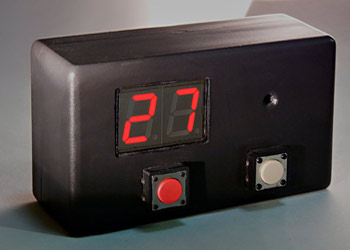TINY program

In
this application, ATTINY2313 uses its internal 1MHz R-C timer as a referent clock source. No microcontroller control flag adjustment is necessary as the default factory setting of the fresh IC is precisely what we need. This clock is not particularly accurate as it is based on an integrated RC oscillator, but for the purpose of the handy kitchen timer it suffices nicely.
When inactive, the timer goes into a deep sleep mode in which the current consumption is approximately 0.15 uA. This lets a pair of alkaline cells to power the timer for several years with ease. Even when active, the timer is designed so that it saves battery energy in an effective way - LED digits are not powered on continually but intermittently for one third of a second every two seconds. That not only divides the power consumption by the factor of 6, but also makes the timer operation visually very attractive. Taking all details into account, average timer consumption in active state is merely around 1mA which means that even a frequent daily use does not influence the battery lifespan too much. It is however advisable to pick a relatively efficient (i.e. ”new“) type of 7-segment display as it is by far the most power-hungry component in the circuit.
Other uses
There are two additional outputs that are not normally utilised in a stand-alone timer. The first one is “In use” output (pin 9) that is in logic high state for as long as the timer is active (both counting down and beeping). That may be useful if one wants to control the operation of some other device with respect to the timer activity. The other output is “Alarm” (pin 11), which turns logic high if the time has successfully run out and beeping becomes active. This pin can be used to for example turn on the light bulb via a relay if the timer is to be used by someone with less than perfect hearing, or to activate a bell, ignite a bar of TNT or initiate some other interesting event indicating that the time has run out. Please note that connecting both of those pins to external circuits should be done with caution as in some cases lethal AC voltage might find its way to keys! This should by any means be left to more experienced folks - LP cannot accept responsibility for potential damage caused to the equipment or injuries caused to people nearby.
So there you are. If feeling crafty, power up the soldering iron, burn the software into controllers and make as many world saving timers as needed by your relatives and friends. LP has built several instances of these devices for beloved ones so far and all of them very soon become respectable pieces of kitchen equipment.

 In this application, ATTINY2313 uses its internal 1MHz R-C timer as a referent clock source. No microcontroller control flag adjustment is necessary as the default factory setting of the fresh IC is precisely what we need. This clock is not particularly accurate as it is based on an integrated RC oscillator, but for the purpose of the handy kitchen timer it suffices nicely.
In this application, ATTINY2313 uses its internal 1MHz R-C timer as a referent clock source. No microcontroller control flag adjustment is necessary as the default factory setting of the fresh IC is precisely what we need. This clock is not particularly accurate as it is based on an integrated RC oscillator, but for the purpose of the handy kitchen timer it suffices nicely.